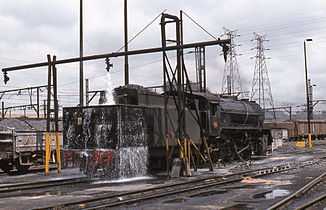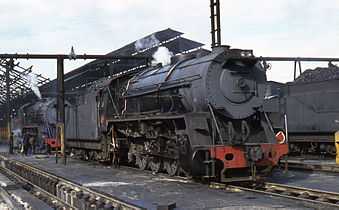South African Class S1 0-8-0
| South African Class S1 0-8-0 | |
|---|---|
|
No. 3814 in Germiston yard, August 1973 | |
| Type and origin | |
| Power type | Steam |
| Designer | South African Railways |
| Builder |
South African Railways (374-385) North British Locomotive (3801-3825) [1] |
| Serial number |
SAR none NBL 27261-27285 [2] |
| Model | Class S1 |
| Build date | 1947-1952 |
| Total produced | 37 |
| Specifications | |
| Configuration | 0-8-0 "Eight-coupled" |
| Gauge | 3 ft 6 in (1,067 mm) Cape gauge |
| Driver diameter | 48 in (1,220 mm) [3] |
| Minimum curve | 165 ft (50.292 m) [4] |
| Wheelbase |
Total: 49 ft 0.0625 in (14.937 m) Engine: 14 ft 9 in (4.496 m) Tender: 6 ft 2 in (1.880 m) bogie 20 ft 5 in (6.223 m) total |
| Length | 64 ft 6.1875 in (19.664 m) |
| Height | 12 ft 11.875 in (3.959 m) |
| Frame | Bar frame |
| Axle load | 19.9 long tons (20.2 t) on 2nd driver |
| Weight on drivers | 74.4 long tons (75.6 t) |
| Locomotive weight | 74.4 long tons (75.6 t) |
| Tender weight |
62,416 lb (28.3 t) empty 65.65 long tons (66.7 t) w/o |
| Locomotive and tender combined weight |
149,240 lb (67.7 t) empty 140.05 long tons (142.3 t) w/o |
| Tender type |
JT1 * 2 axle bogies * 34 in (864 mm) wheels |
| Fuel type | Coal |
| Fuel capacity | 11 long tons (11.2 t) |
| Water capacity | 6,000 imp gal (27,000 l) |
| Boiler |
5 ft 10.5 in (1.791 m) inside diameter 13 ft 2.5 in (4.026 m) inside length 9 ft 2 in (2.794 m) pitch |
| Boiler pressure | 180 psi (1,240 kPa) |
| Firegrate area | 42 sq ft (3.902 m2) |
| Heating surface: – Tubes |
151 tubes 2 in (50.8 mm) diameter 30 tubes 5.5 in (140 mm) diameter 1,600 sq ft (148.645 m2) |
| – Flues | 52 sq ft (4.831 m2) |
| – Firebox | 168 sq ft (15.608 m2) |
| – Total | 1,820 sq ft (169.084 m2) |
| Superheater area | 428 sq ft (39.763 m2) |
| Cylinders | Two |
| Cylinder size |
23.25 in (591 mm) bore 25 in (635 mm) stroke |
| Valve gear | Walschaerts |
| Performance figures | |
| Tractive effort | 38,000 lbf (169 kN) at 75% pressure |
| Career | |
| Operator(s) | South African Railways [3] |
| Class | Class S1 |
| Number in class | 37 |
| Number(s) |
374-385 (SAR built) 3801-3825 (NBL built) [1] |
| Delivered | 1947-1954 |
| First run | 1947 [1] |
The South African Class S1 0-8-0 of 1947 is a South African steam locomotive from the South African Railways era.
In 1947 the South African Railways placed twelve Class S1 shunting steam locomotives with a 0-8-0 wheel arrangement in service, built in the Salt River workshops in Cape Town. A further twenty-five, built in Scotland, were placed in service in 1954.[1][5]
Manufacturers
A huge increase in traffic over the pre-World War II years led to the available dedicated shunting locomotives of the South African Railways (SAR) being very much over-taxed, to the extent that they had to be supplemented by mainline locomotives. During 1943 the requirement for more specialised shunting locomotives was identified by the SAR, but since the war was still in progress, it was not viable to obtain locomotives from the usual overseas suppliers.[1][5]
Dr M.M. Loubser, Chief Mechanical Engineer (CME) of the SAR from 1939 to 1949, therefore prepared designs for a larger version of the Class S locomotive that had been introduced in 1929, that could be built in the SAR’s own workshops. The result was the Class S1 0-8-0 shunting locomotive, of which the first of twelve was delivered from the Salt River workshops in Cape Town in October 1947.[1][5]
The first locomotive was formally handed over to the Operating Department by the senior member of the Railway Board, Mr F.T. Bates. In honour of the occasion it was named "Voortrekker".[1][5]
The twelve locomotives were numbered in the range from 374 to 385. The Class S1 was the first steam locomotive to be designed and built by the SAR in quantity, although not the first to be designed and built in South Africa. The Natal Government Railways 2-8-2TT tank-tender locomotive "Havelock" had already taken that honour in 1888.[5][6]
After the war a further twenty-five Class S1 locomotives were ordered from the North British Locomotive Company (NBL) in Glasgow. They were built in 1952 and delivered in 1953 and 1954, numbered in the range from 3801 to 3825.[1][2]
Characteristics
The locomotives had bar frames, Walschaerts valve gear and were superheated. While their cylinders, driving wheel diameter, chassis and many other features were similar to that of the existing Class S shunting locomotives, their boilers were much larger, being a shortened version of the specially designed boiler that was used on the Class 12AR.[5][7]
Since shunting locomotives are designed to operate at low speeds in tightly curved shunting yards, there was no need for the leading or trailing wheels that are necessary on mainline locomotives to improve high speed stability. In addition it is desirable to have as large a proportion of the locomotive weight as possible carried on the coupled wheels to obtain the maximum adhesion. As on that of the Class S, the top sides of its Type JT1 tender’s coal bunker were set inwards to improve the crew’s rearward vision.[1][4][7]
The Class S1 was noted for its efficient and economical working. They were the SAR’s largest and finest shunting locomotives with quite an enormous shifting and accelerating ability, and could cope with block loads of up to 2,000 long tons (2,000 tonnes).[7]
Service
The Class S1 was initially placed in service in the yards in Cape Town, but they ended up being used mainly in marshalling yards on the Transvaal Western System and on occasion also on the Cape Northern System, employed at Bloemfontein and Kimberley. By the 1970s they were distributed between Beaconsfield in Kimberley, Bloemfontein, Germiston, Kaserne, Springs and Witbank.[5][7]
By 1982 they were all stationed at Germiston and its sub-depot at Kaserne, after which they began to be withdrawn from service. The withdrawal was probably expedited by the closure of the Koedoespoort works in Pretoria to steam repairs, since it was impractical to let them do long distance running to the next nearest steam locomotive works at Bloemfontein.[7]
None of them were sold into industrial service.[7]
Works numbers
The builders, works numbers, year built and SAR locomotive numbers of the Class S1 are listed in the table.[1]
Builder |
Works no. |
Year |
SAR no. |
|---|---|---|---|
| SAR | 1947 | 374 | |
| SAR | 1947 | 375 | |
| SAR | 1947 | 376 | |
| SAR | 1947 | 377 | |
| SAR | 1947 | 378 | |
| SAR | 1947 | 379 | |
| SAR | 1947 | 380 | |
| SAR | 1947 | 381 | |
| SAR | 1947 | 382 | |
| SAR | 1947 | 383 | |
| SAR | 1947 | 384 | |
| SAR | 1947 | 385 | |
| NBL | 27261 | 1952 | 3801 |
| NBL | 27262 | 1952 | 3802 |
| NBL | 27263 | 1952 | 3803 |
| NBL | 27264 | 1952 | 3804 |
| NBL | 27265 | 1952 | 3805 |
| NBL | 27266 | 1952 | 3806 |
| NBL | 27267 | 1952 | 3807 |
| NBL | 27268 | 1952 | 3808 |
| NBL | 27269 | 1952 | 3809 |
| NBL | 27270 | 1952 | 3810 |
| NBL | 27271 | 1952 | 3811 |
| NBL | 27272 | 1952 | 3812 |
| NBL | 27273 | 1952 | 3813 |
| NBL | 27274 | 1952 | 3814 |
| NBL | 27275 | 1952 | 3815 |
| NBL | 27276 | 1952 | 3816 |
| NBL | 27277 | 1952 | 3817 |
| NBL | 27278 | 1952 | 3818 |
| NBL | 27279 | 1952 | 3819 |
| NBL | 27280 | 1952 | 3820 |
| NBL | 27281 | 1952 | 3821 |
| NBL | 27282 | 1952 | 3822 |
| NBL | 27283 | 1952 | 3823 |
| NBL | 27284 | 1952 | 3824 |
| NBL | 27285 | 1952 | 3825 |
Features illustrated
The main picture and the following photographs illustrate SAR and NBL built Class S1 locomotives and also show the special shape of the tender's coal bunker.
-

SAR built no. 380 with enough water at Kaserne, 19 March 1983
-

SAR built no. 381 at Germiston Loco, 23 April 1979
-
.jpg)
NBL built no. 3819 at Germiston Loco, 26 June 1963
See also
- List of South African locomotive classes
- South African Class S 0-8-0
- South African Class S2 0-8-0
- South African locomotive history
- Tender locomotive numbering and classification
- The 0-8-0 "Eight-coupled"
References
|
- ↑ 1.0 1.1 1.2 1.3 1.4 1.5 1.6 1.7 1.8 1.9 Holland, D.F. (1972). Steam Locomotives of the South African Railways, Volume 2: 1910-1955 (1st ed.). Newton Abbott, Devon: David & Charles. pp. 103–104. ISBN 978-0-7153-5427-8.
- ↑ 2.0 2.1 North British Locomotive Company works list, compiled by Austrian locomotive historian Bernhard Schmeiser
- ↑ 3.0 3.1 South African Railways and Harbours Locomotive Diagram Book, 2’0” & 3’6” Gauge Steam Locomotives, 15 August 1941, as amended
- ↑ 4.0 4.1 SAR, PR Department (1947). The South African Railways - History, Scope and Organisation (1st, June 1947 ed.). Johannesburg: SAR Public Relations Department. p. 97.
- ↑ 5.0 5.1 5.2 5.3 5.4 5.5 5.6 Paxton, Leith; Bourne, David (1985). Locomotives of the South African Railways (1st ed.). Cape Town: Struik. pp. 80–81. ISBN 0869772112.
- ↑ Holland, D.F. (1971). Steam Locomotives of the South African Railways, Volume 1: 1859-1910 (1st ed.). Newton Abbott, Devon: David & Charles. pp. 90–91. ISBN 978-0-7153-5382-0.
- ↑ 7.0 7.1 7.2 7.3 7.4 7.5 Durrant, A E (1989). Twilight of South African Steam (1st ed.). Newton Abbott, London: David & Charles. p. 121. ISBN 0715386387.
.jpg)